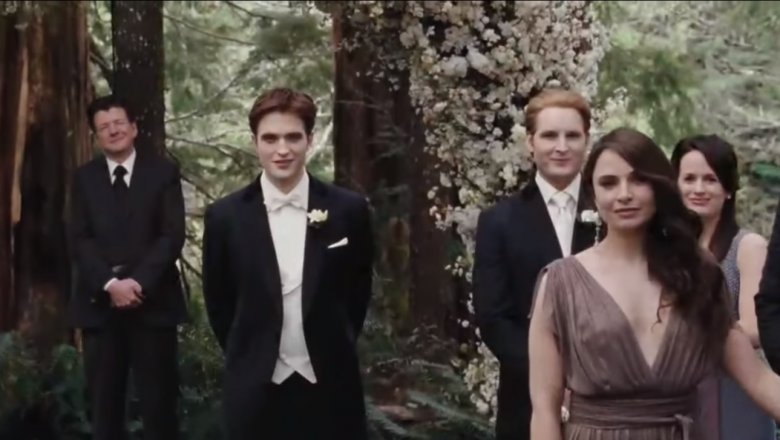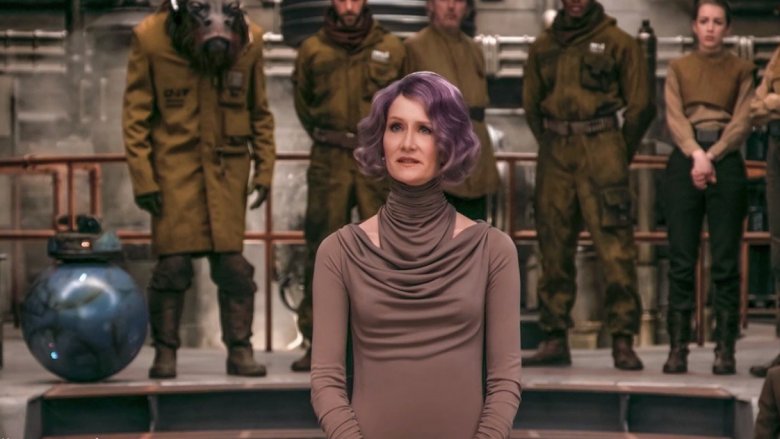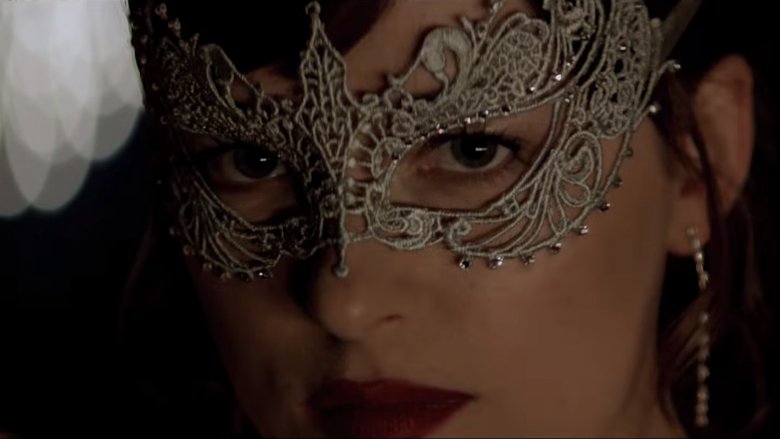Movies That Caused Theaters To Post Warning Signs
There are many reasons a movie theater might post warning signs to their customers regarding a specific film. Usually, it's to protect the theater from liability issues surrounding the concern to patrons' health or safety, sometimes it's for marketing or other reasons. Read on to learn of films, both new and old, that led theater owners to display warning disclaimers to their patrons.
Warning: Terrence Malick film
Terrence Malick is something of a divisive filmmaker. His emotionally resonant stylistic choices have, by turns, earned him praise, as with The Thin Red Line, and scorn, as with 2012's To The Wonder. Film scholar Lloyd Michaels said of Malick, "Few American directors have inspired such adulation and rejection with each successive film."
After over 40 years in the film business, you'd think that audiences would be somewhat familiar with Malick and his auteur quirks. That wasn't the case with some audience members who went to see his 2011 film Tree of Life at the Avon Theatre in Stamford, Connecticut. The non-profit art-house theater seems like the best possible setting for Malick's meditation on the meaning of life as viewed through the lens of a 1950s Texas family. Still, management decided to post the following sign to audiences:
"In response to some customer feedback and a polarized audience response from last weekend, we would like to take this opportunity to remind patrons that The Tree of Life is a uniquely visionary and deeply philosophical film from an auteur director. It does not follow a traditional, linear narrative approach to storytelling. We encourage patrons to read up on the film before choosing to see it, and for those electing to attend, please go in with an open mind and know that the Avon has a NO-REFUND policy once you have purchased a ticket to see one of our films."
A photo of the sign was posted to social media and quickly went viral. Indiewire spoke to Avon's director of business development and programming, Adam Brinbaum, who said: "The overwhelming response to the film was, in fact, positive ... but there were a few individuals who were fairly nasty and belligerent towards the management staff, demanding their money back."
Warning: Witchy woman casts sickening spell
"I'm scared to close my eyes, and I'm scared to open them. I'm going to die out here." Actress Heather Donahue, using her real name to portray a young documentarian in 1999's The Blair Witch Project, improvised those infamous lines. Her fictional film shoot goes about as badly as one can imagine; shortly after that memorable scene, the film ends with the off-camera sound of Heather's incoherent screams.
It's hard to underestimate the impact The Blair Witch Project had. It was an early form of reality entertainment: Actors improvised scenes based on instructions the production team left for them at GPS drop points. Its popularity launched the found footage horror trend of the early 2000s. The filmmakers were among the first to tout website page views, not critic reviews, in their advertising: "blairwitch.com: 21,222,589 hits to date."
The film was an overwhelming success, made initially for around $25,000 and taking in nearly $250 million, but theater owners paid a revolting price for all those ticket sales. The shaky camera work, filmed by the actors themselves, led many an audience member to throw up in the theater. Tulane University Hospital and Clinic audiologist John Risey explained to The Washington Post in 1999: "What happens is the camera and the brain mismatch messages. Because you are seated and you are still, your brain gets wrong information that you are in motion."
This led theater owners to post warning signs before the film in some cases, while others, like Bonnie Hunsaker, manager of the AMC Colonial 18 in Lawrenceville, Georgia, posted signage to their patrons: "This past weekend we put up a sign that said the hand-held camera can create motion sickness, and if you're susceptible to motion sickness you may want to rethink your viewing choice," Hunsaker told reporters.
Warning: Alien invasion may feel like a rollercoaster
The found-footage era may have been kicked off by The Blair Witch Project in 1999, but it was still going strong in 2008 when J.J. Abrams produced Cloverfield. The monster movie spun a classic disaster film narrative from the point of view of six New York City residents. Their attempts to flee the wreckage, caused by a largely unseen alien invader, are captured in camcorder footage recovered by the Department of Defense.
The marketing for Cloverfield echoed elements of Blair Witch, incorporating hidden images to the website, creating Myspace.com pages (when those were still a thing) for the film's protagonists, and even a fake soft drink tie-in. The strategy paid off; Cloverfield enjoyed an over $40 million dollar opening and grossed more than $170 million dollars worldwide. However, the success of a viral campaign isn't the only similarity to Blair Witch.
Mann Theatres Chief Executive Peter Dobson noted four cases of illness among his theatre chains in Los Angeles and Glendale during Cloverfield's opening: "I must confess I was a little surprised, but sometimes ... this happens," Dobson said. "It's not normal to get four in a weekend." In response, AMC theaters took action, posting warning signs alerting moviegoers to potential "side effects associated with motion sickness similar to riding a roller-coaster."
Warning: 1 hour of 127 Hours may be too much for you
Director Danny Boyle hasn't ever shied away from making his audiences uncomfortable. His directorial film debut Shallow Grave features a cringe-inducing dismemberment scene, while his signature Trainspotting and zombie flick 28 Days Later both have any number of stomach-turning moments to choose from. The moments in question, though, are nearly always underpinned by uncomfortable truths.
Similarly, in 127 Hours, the harsh reality of the real-life amputation story the film depicts is confronted head on. The idea that the entire scenario could have been avoided through a simple precaution (e.g., leaving a note about one's whereabouts) informs the brutal consequences of that reckless overconfidence.
Before 127 Hours even made it to theatrical release, the buzz regarding the potential health risks of viewing the film was in full swing. A series of fainting spells, one seizure, and reports of vomiting piled up as the film traveled the festival and industry screening circuit. A man who passed out at a film festival in Denver told his story, which included treatment from paramedics onsite.
Paul Asay, senior associate editor of Pluggedin.com noted in his review of 127 Hours: "It's been reported that Aron's amputation sequence has made moviegoers faint or vomit. The theater in which I saw the film actually had a warning sign posted to the door." For those who might want a more detailed warning, Vulture posted a "squeamish person's guide" to viewing the film, which includes time stamps to warn of the scenes most likely to induce illness.
Warning: Not even the Queen can be late
It's hard to imagine a world in which the shocking twists from Alfred Hitchcock's 1960 classic Psycho aren't common knowledge. Yet, in the late fifties, Psycho was merely a novel written by Robert Bloch, who'd enjoyed some popularity in the genre of science-fiction writing. When Hitchcock bought the rights to Bloch's fictional novel about a multiple murderer who conceals his crimes in small-town America, the author had faith in the filmmaker.
"I knew his film adaptations from novels," Bloch explained in 1999, "were very much changed — The Secret Agent, Suspicion, or Spellbound, for example." He continued, "However, I felt that there wasn't much point in him buying this particular book unless he meant to use the storyline." Bloch was right. Moreover, Hitchcock was committed to preserving the integrity of the resulting film at all costs. According to writer Stephen Rebello: "Hitchcock — to keep the surprises of Psycho as surprises — reportedly ordered [assistant] Peggy Robertson to buy up as many copies of the novel as possible from the publisher and from bookstores."
This obsessive desire to control the experience of the audience extended to Hitchcock enforcing an admittance policy among theater owners while Psycho was in limited release. Detailed time schedules were released for theaters in New York, Chicago, Boston, and Philadelphia. The following signs were placed in those cinemas:
"We won't allow you to cheat yourself. You must see Psycho from the very beginning. Therefore, do not expect to be admitted into the theatre after the start of each performance of the picture. We say no one — and we mean no one — not even the manager's brother, the President of the United States, or the Queen of England (God bless her)!"
The policy was even enforced by a Pinkerton guard [an infamous private security force and detective agency] that was hired to bar latecomers from entering the theater.
Warning: Creative choices (and spoilers) ahead
When The Last Jedi hit theaters before Christmas in 2017, anticipation for the new entry in the Star Wars sequel trilogy was at its zenith. Some fans were installing browser blockers to avoid spoilers. Others made announcements that they would avoid social media entirely until after they'd seen the film, and even Mark Hamill himself pleaded with the internet to keep the film's plot a surprise.
With all that in mind, it's surprising that two AMC theaters decided to post the following warning sign regarding a pivotal scene from the film:
"Please note: The Last Jedi contains a sequence at approximately 1 hour and 52 minutes into the movie in which ALL sound stops for about 10 full seconds. While the images continue to play on the screen you will hear nothing. This is intentionally done by the director for a creative effect."
The theater chain reportedly confirmed that the sound drop from this moment, in which Vice Admiral Holdo sacrifices herself by ramming her ship through Supreme Leader Snoke's vessel while at lightspeed, was "a repeated point of confusion" among its patrons. Apparently some audience members complained, thinking the lack of sound was due to a technical glitch. The approach seems to have backfired — it was also reported that the warning sign itself generated new complaints from patrons saying it "effectively spoiled one of the most pivotal moments in the film."
Warning: Management is not responsible for offense
At a Q&A which followed a 2016 screening of his 1974 Western parody Blazing Saddles, special guest Mel Brooks was told by moderator Kevin Salter that the question he runs into most often about the film is whether it could even be made today. While Salter said the answer was a resounding "no," he also said,"But I actually don't think it could have really been made in 1974 either."
Brooks agreed with Salter's assertion, explaining that he told his team of writers, which included legendary comedian Richard Pryor, "Don't be afraid of anything, just write crazy because, probably, they'll never make this movie." Brooks continued, "And secondly if they do make the movie, you'll be arrested." Still, Warner Bros. did ultimately approve the film.
That didn't stop the studio from having second thoughts following their screening of the finished product. Said Brooks: "... It's crazy, it's dangerous. There's the N-word, it's really a dangerous movie. So I show it to a group of executives. Not a word, nothing, zip, zilch ... The domestic distributor for Warner Bros. stands up ... and he says, 'I have never asked Warner Bros. to bury a film. But I think we should eat the money and never show this disgusting film.'"
The studio released the film following successful test screenings. The content still worried some theater owners though, as a film blogger raised in New Jersey recalls: "When I saw Blazing Saddles in the theater, I remember seeing a sign on the doors of the General Cinemas Hudson Mall in Jersey City. It read, 'Please be aware that Blazing Saddles contains material that may be considered offensive to some viewers. The management is not responsible for its content.'"
Warning: Plastic spoon throwing may occur
It numbers among its fans comedian David Cross and actor Paul Rudd. It was described as "one of the most important films of the past decade ... [exposing] the fabricated nature of Hollywood," by Ross Morin, an assistant professor of film studies at St. Cloud State University in Minnesota. It's The Room, of course, the 2003 release produced, directed by, and starring Tommy Wiseau.
Morin calls it "the Citizen Kane of bad movies." The Room was barely released at all, playing for two weeks at only two theaters in 2003. It was advertised by a black and white billboard overlooking Highland Avenue for five years.
Retroactively dubbed a "black comedy" by Wiseau, it's been afforded a cult status that led to Rocky Horror Picture Show-style midnight screenings where fans shout dialogue at the screen and perform skits. In 2017, James Franco directed and starred in The Disaster Artist, based on a book co-written by Greg Sestero, who acted in The Room, detailing his experiences during production.
Some theaters still screen The Room regularly, like the Music Box Theatre in Chicago. On its website listing for The Room, the theater posted: "**Disclaimer – Midnight screenings of The Room involve loud, angry crowds shouting at the screen and throwing plastic spoons.**" Looper contacted the operations supervisor, Buck LePard, who explained that, although The Music Box doesn't post physical signs, it required a digital disclaimer: "The Disaster Artist has created new interest from folks who were previously unaware of the film." And, thus, they'd be unaware of the midnight mayhem.
Warning: May leave you foaming at the mouth
Whether you loved it or hated it, The Twilight Saga: Breaking Dawn – Part 1 was a worldwide smash-hit, bringing in over $712 million dollars. Some fans couldn't wait to cheer on the wedding of teenager Bella Swan to her vampiric sweetheart Edward Cullen. Other fans couldn't wait to lament this final nail in the coffin for werewolf Jacob Black's romantic pursuit of Bella. The film also saw Bella and Edward consummate their relationship in a bed-destroying love scene that leaves Bella pregnant.
The resulting birth scene was visually brutal, with actress Kristen Stewart portraying a diminished and gaunt Bella whose pregnancy takes a toll on her body, breaking her spine and requiring a vicious cesarean. The intensity of the scene, however, is not what caused moviegoers to collapse. A flashing white light effect apparently triggered seizures in some audience members.
The crisis led the Epilepsy Foundation to post about the film on its website. The group warned that "people with photosensitive epilepsy, including some who may not be aware of their condition, are at risk of experiencing convulsions when viewing the scene." It got so bad that a crowd-sourced document to track incidences of seizure activity after viewing Breaking Dawn – Part 1 was created. It detailed over 25 such cases, most of them from people who were unaware they had photosensitive epilepsy.
In response, warning signs were posted around the country, including one at a Regal theater in California which read: "It has come to our attention that short sections of 'The Twilight Saga: Breaking Dawn – Part 1' contain flashing light sequences that may cause seizures in people who are susceptible to photosensitive epilepsy."
Warning: Single men unwelcome
In addition to the serious warning signs posted by movie theaters in an attempt to prevent patrons from harm or asking for refunds, there are sillier examples of these kinds of warnings that pop up in connection with all kinds of films. Take the case of the Diamond Cinema in Navan, Ireland, which recorded the following message on its phone listings for the "18 cert" (the Ireland and U.K. version of an R rating, more or less) film Fifty Shades Darker, based on the popular series of erotic fiction books by E.L. James:
"If you're looking to go to 'Fifty Shades Darker' and you're bringing your boyfriend, you better keep lots of space between you. It's on an 18 cert, and I must stress that single men or married men on their own, any unaccompanied males will not be allowed in."
Before you get up in arms that a theater would outright ban a gender from a film's entire run, Paul Egan of Diamond Cinema, was just making a joke. After falling asleep during the first Fifty Shades film, he impishly thought "it might be better to keep the men outside the door until we see if women can control themselves" for the second one.
Warning: You might need a priest
Taking a leaf out of Alfred Hitchcock's Psycho playbook, no doubt, New Line Cinema sponsored a memorable screening in Chicago of James Wan's supernatural thriller The Conjuring that came with its own, studio-issued warning sign. The film depicts the supposed "true-life" events surrounding a demonic presence terrorizing a family that has just moved into a remote farmhouse. The warning sign at the Chicago screening read:
"Warning. The film you are about to see is psychologically and emotionally disturbing. People who have attended early screenings of the film have complained about many unusual circumstances that they have experienced after seeing this film. Due to our concern for your well-being we have invited Father Malave to be here. He will be available after the film to provide spiritual support and/or conduct a personal blessing should you feel the need. Please do not hesitate to seek help. Ask a representative where you can sign up for a session with our Priest."
Father Malave was reportedly a real Priest who blessed the audience in attendance and even commented to reporters following the screening on the nature of evil, warning to not let films like The Exorcist or The Conjuring "domesticate the power of evil."











